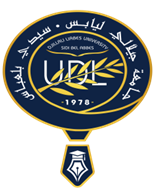Détermination de quelques propriétés physicochimiques des amidons de Gingembre (Zingiber officinale) et de Curcuma (Curcuma longa) commercialisés à Sidi Bel Abbés
Loading...
Date
2020-09
Journal Title
Journal ISSN
Volume Title
Publisher
Abstract
Résumé : ( Français )
Le gingembre (Zingiber officinale) et le curcuma (Curcuma longa) sont des plantes herbacées dont les vertus thérapeutiques sont mondialement connues. En vue de valoriser ces deux plantes, particulièrement leurs rhizomes, nous avons entrepris dans ce travail de quantifier l’amidon, l’amylopectine et l’amylose dans les deux épices ensuite d’étudier quelques propriétés comme le pouvoir de gonflement, la solubilité, le potentiel d’hydrogène et la
gélatinisation. La mesure de l’ensemble amylose-amylopectine et amylose seule se fait sur la base de l’absorption à 580 et 720 nm respectivement. Les résultats montrent que les taux d’amidons dans les deux produits sont respectivement de 56,25±0,67% et 50,22±0,93% pour le gingembre et le curcuma. L’amylose et l’amylopectine présentent des quantités de 27,35±1% et 72,65±1,34 pour Z. officinale et 32±1,93% et 68±0,87% pour C. longa. Le taux d’amidon ainsi que celui de l’amylopectine du gingembre sont supérieurs à ceux du curcuma ce qui n’est pas le cas de l’amylose dont le taux est important dans le curcuma (p<0.05). Nos résultats ont montré que lorsque la température augmente, le gonflement augmente. L’amidon présente un très faible taux de gonflement de 60 à 85 °C pour le gingembre et de 50°C à 70°C pour le curcuma. Mais au-delà de ces températures le pouvoir de gonflement en g/g d’amidon augmente fortement. Une forte augmentation de la solubilité dans l'eau est aussi observée à partir de 70 °C pour l'amidon de Curcuma longa et de 80°C pour Zingiberofficinalis. Les pH
des deux produits sont de 06,52 et 07,04 respectivement pour le gingembre et le curcuma. La gélatinisation de l’amidon de curcuma observée au microscope optique est atteinte à une température de 70°C tandis que celle du gingembre à 80°C. Ces différentes propriétés physicochimiques sont en faveur d’une utilisation de ces amidons comme épaississants et gélifiants en agroalimentaire et comme excipient en pharmaceutique.
mots clés : gingembre , curcuma ,propriètés physicochimiques , épaississants , gélifiants.
Abstract : ( Anglais)
Ginger (Zingiberofficinale) and turmeric (Curcuma longa) were herbaceous plants whose therapeutic properties were known worldwide. In order to enhance these two plants, particularly their rhizomes, we undertook in this work to quantify the starch, amylopectin and amylose in the two spices then to study some properties such as the swelling power, the solubility, the hydrogen potential and gelatinization. The measurement of amyloseamylopectin and amylose alone was made on the basis of absorption at 580 and 720 nm respectively. The results show that the starch levels in the two products were 56.25 ± 0.67% and 50.22 ± 0.93% respectively for ginger and turmeric. Amylose and amylopectin have amounts of 27.35 ± 1% and 72.65 ± 1.34 for Z. officinale and 32 ± 1.93% and 68 ± 0.87% for C. longa. The starch and amylopectin levels of ginger were higher than those of turmeric, which was not the case for amylose, which has a high level in turmeric (p <0.05). Our results have shown that as the temperature increases, the swelling increases. The starch has a very low swelling rate of 60 °C to 85 °C for ginger and 50°C to 70 ° C for turmeric. However, beyond these temperatures the swelling power in g / g of starch increases sharply. A strong increase in water solubility was also observed from 70°C for the starch of Curcuma longa and from 80 ° C for Zingiberofficinalis. The pH of the two products were 06.52 and 07.04 respectively for ginger and turmeric. The gelatinization of turmeric starch observed under an optical microscope was reached at a temperature of 70 ° C while that of ginger at 80 ° C.
These different physicochemical propertieswere in favor of using these starches as thickeners and gelling agents in the food industry and as an excipient in pharmaceuticals.
keywords: ginger , turmeric , physicocemical properties ,thickeners , gelling.
Description
Mémoire master 2 biologie
